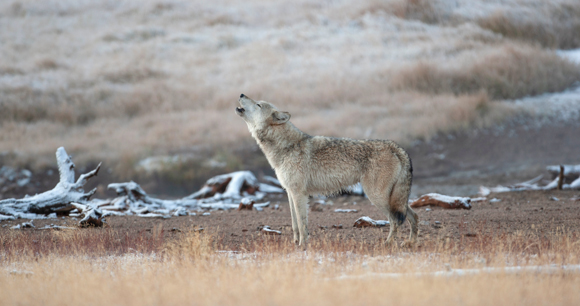by Dr. Angela Dassow, Carthage College
Wolf–human conflicts are an ongoing concern that can lead to both legal and illegal killing of wild wolves, poor support for wild carnivore welfare among local human populations, and legislative changes that negatively affect wolf conservation.

In central Wisconsin, the gray wolf population has grown in recent years to approximately 144–153 wolves across 34 packs. While this recovery has been positive for the conservation prospects of wolves and for the stabilization of the local ecosystem, it has led to a proportional rise in the number of human–wolf conflicts. Therefore, tracking wild wolves is vital for understanding the factors driving their interactions with livestock and activities around farm property in general.
Wolves are shy and largely nocturnal, so obtaining details of their wild behavior can be challenging. Traditional radio-collar methods are effective at tracking the movements of individuals; however, they are expensive and time consuming and can cause injury to the wolves. The goal of our study, partially funded with a Christine Stevens Wildlife Award, was to demonstrate that passive acoustic localization can accurately be used to track the movements of these packs and understand their behaviors without having to capture, collar, or harass them.
The acoustic system we used was based on devices originally tested in Yellowstone National Park (YNP). We deployed 11 passive recording devices equipped with synchronous GPS units and used the difference in the time of arrival of wolf howls at each device to triangulate the position of the howling wolf. Over two weeks of recordings, we detected 190 instances of wolves howling, of which 28 were heard on at least three recording devices, allowing us to pinpoint the location of the animals. We also identified the locations of 69 instances of barking dogs and 42 instances of howling coyotes.
Our results not only demonstrated that the methods used with the wolves in YNP can be effective in habitats where wolf–human conflicts are more frequent, but also generated a data set that is currently being analyzed to understand the vocal interactions between these three species. By using sound to track wolf movements and locations, we can develop suggested mitigation measures to reduce wolf–livestock interactions. Since the acoustic devices also recorded barking dogs and howling coyotes, we hope to expand our suggested mitigation tools to more broadly reduce conflicts between wild predators and farmers.
Given the success of this technology in YNP and Wisconsin, it likely will also be successful in identifying the locations and tracking the movements of predators in other countries, providing a new tool to help mitigate predator–livestock conflicts globally. Indeed, our acoustic system will soon be tested in South Africa to study the interactions between livestock guard dogs and wildlife.